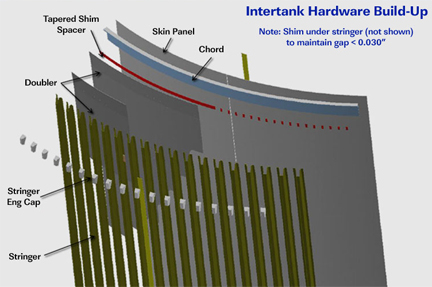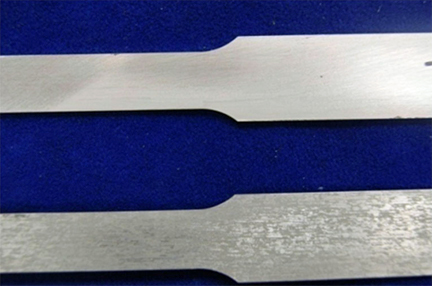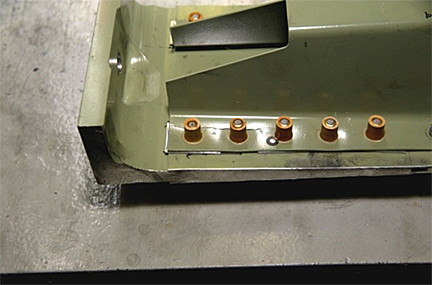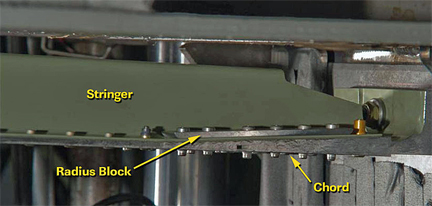NASA zeroes in on root cause of shuttle tank cracks
By WILLIAM HARWOOD
CBS News
KENNEDY SPACE CENTER, FL--Engineers believe they have zeroed in on the root cause of cracks in the shuttle Discovery's external tank, NASA officials said Tuesday. Installation of a relatively simple modification to the tops of the structural ribs, or stringers, where the ship's liquid oxygen tank is supported by a massive flange should resolve the problem once and for all, setting the stage for another launch attempt Feb. 24.
"We're on the road to bringing this tank to a hundred percent," said shuttle Program Manager John Shannon. "It's been two months of very vigorous activity, it took a lot of investigation to piece the different components of how this could be happening together, but I'm very confident we've finally got this figured out and we have a fix that's easy to implement and will be 100 percent effective."
Discovery's late February launch window opens the day after the European Space Agency's unmanned Automated Transfer Vehicle, loaded with supplies and equipment, reaches the International Space Station. The ATV is scheduled for launch from French Guiana on Feb. 15. Mission managers initially planned a docking on Feb. 26, but ESA, NASA and Russian managers have agreed to aim for a docking Feb. 23 instead. Assuming the ATV takes off and docks on time, Discovery would be set for another launch attempt at 4:50:13 p.m. EST on Feb. 24.
If all goes well, NASA hopes to have the shuttle Endeavour ready for launch on its final mission by around April 18. But planning for that flight is somewhat uncertain. Commander Mark Kelly's wife, Rep. Gabrielle Giffords, was shot in the head Saturday in Tucson by a gunman who killed six and wounded 13 others. Giffords remains in critical condition.
At a news briefing Tuesday to discuss the external tank investigation, Bill Gerstenmaier, director of space operations at NASA headquarters in Washington, declined to discuss Kelly's status, saying "out of respect to the family, we really are not ready to answer those questions today."
"We're going to let Mark decide really kind of what he needs to do," Gerstenmaier said. "We'll let his personal situation take focus on his activities and his thoughts and later when we know more about where (the Endeavour mission) sits and what our options are for Mark and his activities, we'll come talk to you at that time. ... Our hearts and prayers go out to the family and we're really thinking about Mark in everything we do."
The external tank crack problem first surfaced during fueling for a Nov. 5 launch attempt. Discovery's countdown was called off because of a gaseous hydrogen leak, a problem that was later resolved. But engineers also noticed a large crack in the external tank's foam insulation that developed during fueling. When the foam was removed later, four cracks were found in the "feet" of two adjacent ribs, or stringers, in a compartment that separates the tank's liquid oxygen and hydrogen sections.
The cracks presumably developed when the liquid oxygen tank was loaded with super-cold propellant, causing the flange that supports it to contract, pulling the top few inches of the intertank stringers inward. Tank components are designed to cope with that stress without breaking but for some reason, cracks developed near the tops of two stringers in Discovery's tank.
Engineers were immediately concerned, citing two potentially serious issues. Cracked stringers could result in foam insulation falling off during flight that could pose an impact threat to the shuttle's fragile heat shield. And if enough stringers failed, the structural integrity of the tank could be in question.
NASA launched a wide-ranging investigation to figure out the root cause of the cracks and what might be needed to correct the problem. A full-scale instrumented fueling test was carried out Dec. 17 to precisely map out the stresses acting on the tank during fueling. Discovery then was moved off the pad and back to the Vehicle Assembly Building for additional inspections.
Engineers then found four more cracks on the back side of the tank near the tops of three stringers, which could not be inspected at the launch pad. Like the first set of cracks, these were repaired by splicing in fresh stringer segments and attaching doublers for additional strength.
Believing built-in stresses from assembly likely caused the cracks, engineers proposed installing doublers on stringers to either side of massive solid rocket booster attachment panels that experience the most stress during flight.
But as it turned out, the issue was more complicated than first suspected. Engineers reviewing manufacturing records discovered that the aluminum-lithium alloy used in 78 of the 108 stringers in the intertank of Discovery's external tank came from a batch that had a mottled appearance, possibly the result of heat treatments during the alloy's formulation. Testing showed the material used in those stringers had just 65 percent of the expected fracture strength.
On New Year's Eve, Shannon said, engineers successfully re-created a crack using the same mottled aluminum-lithium alloy in a test rig that subjected it to the same sorts of stress the tank experiences during fueling.
"We absolutely have root cause and we have been able to show that through test," he said. "It's a combination of two factors. It's the low fracture toughness of the material, we have about 65 percent of the expected fracture toughness, combined with some assembly stresses that were built up in different areas.
"We know that because when we loaded the tank (with propellant), we put high stress on all of those stringers that had that low fracture toughness and we only had cracks in five of what we believe were 78 stringers. In looking at those stringers that cracked, we're seeing the evidence of those assembly stresses that combined with that low fracture toughness to cause the problem. So we have root cause and we have a fix that we're completely confident will eliminate those root causes."
The fix is installation of radius block plates all the way around the circumference of the upper intertank to beef up the under-strength stringers. The repair calls for engineers to remove the top few rivets holding the sides of each stringer in place. An aluminum plate -- a radius block -- is then placed over the stringer attachment "feet" and riveted into place. The idea is to lock the stringer flat against the side of the tank and make it less susceptible to the stresses that could cause fractures to develop.
Shannon said engineers are carrying out tests and analyses to make sure the repairs do not introduce any unintended consequences.
"We're proving that out through tests, we're looking at the strain, we're looking at the stiffness and verifying in the tests that material that does not have a radius block does not behave any different than one that does have a radius block," he said. "We're going through and modeling that through the entire tank and verifying we're not going to do any harm. Right now, it looks really good."
The repair work is expected to be completed by around Jan. 23. After that, engineers will move Discovery back to pad 39A for work to ready the ship for launch.
CBS News
KENNEDY SPACE CENTER, FL--Engineers believe they have zeroed in on the root cause of cracks in the shuttle Discovery's external tank, NASA officials said Tuesday. Installation of a relatively simple modification to the tops of the structural ribs, or stringers, where the ship's liquid oxygen tank is supported by a massive flange should resolve the problem once and for all, setting the stage for another launch attempt Feb. 24.
"We're on the road to bringing this tank to a hundred percent," said shuttle Program Manager John Shannon. "It's been two months of very vigorous activity, it took a lot of investigation to piece the different components of how this could be happening together, but I'm very confident we've finally got this figured out and we have a fix that's easy to implement and will be 100 percent effective."
 |
| A drawing showing the components of the intertank of the shuttle's external tank. The top few inches of the vertical stringers, which are pulled inward during fueling by low-temperature contraction, can experience cracks where fasteners attach them to the tank. (Photo: NASA) |
 |
| Normal aluminum-lithium alloy, using in external tank stringers, is shown in the top sample. Mottled material in the lower sample was used in Discovery's external tank. It has a lower fracture strength. (Photo: NASA) |
At a news briefing Tuesday to discuss the external tank investigation, Bill Gerstenmaier, director of space operations at NASA headquarters in Washington, declined to discuss Kelly's status, saying "out of respect to the family, we really are not ready to answer those questions today."
 |
| Engineers successfully duplicated a crack in a stringer using a test rig that subjected the U-shaped stringer to the forces experienced during fueling. (Photo: NASA) |
The external tank crack problem first surfaced during fueling for a Nov. 5 launch attempt. Discovery's countdown was called off because of a gaseous hydrogen leak, a problem that was later resolved. But engineers also noticed a large crack in the external tank's foam insulation that developed during fueling. When the foam was removed later, four cracks were found in the "feet" of two adjacent ribs, or stringers, in a compartment that separates the tank's liquid oxygen and hydrogen sections.
 |
| NASA's proposed fix calls for bolting so called "radius blocks" over stringer attachment fittings to ensure a flat, tight fit, making them less susceptible to cracking. (Photo: NASA) |
Engineers were immediately concerned, citing two potentially serious issues. Cracked stringers could result in foam insulation falling off during flight that could pose an impact threat to the shuttle's fragile heat shield. And if enough stringers failed, the structural integrity of the tank could be in question.
NASA launched a wide-ranging investigation to figure out the root cause of the cracks and what might be needed to correct the problem. A full-scale instrumented fueling test was carried out Dec. 17 to precisely map out the stresses acting on the tank during fueling. Discovery then was moved off the pad and back to the Vehicle Assembly Building for additional inspections.
Engineers then found four more cracks on the back side of the tank near the tops of three stringers, which could not be inspected at the launch pad. Like the first set of cracks, these were repaired by splicing in fresh stringer segments and attaching doublers for additional strength.
Believing built-in stresses from assembly likely caused the cracks, engineers proposed installing doublers on stringers to either side of massive solid rocket booster attachment panels that experience the most stress during flight.
But as it turned out, the issue was more complicated than first suspected. Engineers reviewing manufacturing records discovered that the aluminum-lithium alloy used in 78 of the 108 stringers in the intertank of Discovery's external tank came from a batch that had a mottled appearance, possibly the result of heat treatments during the alloy's formulation. Testing showed the material used in those stringers had just 65 percent of the expected fracture strength.
On New Year's Eve, Shannon said, engineers successfully re-created a crack using the same mottled aluminum-lithium alloy in a test rig that subjected it to the same sorts of stress the tank experiences during fueling.
"We absolutely have root cause and we have been able to show that through test," he said. "It's a combination of two factors. It's the low fracture toughness of the material, we have about 65 percent of the expected fracture toughness, combined with some assembly stresses that were built up in different areas.
"We know that because when we loaded the tank (with propellant), we put high stress on all of those stringers that had that low fracture toughness and we only had cracks in five of what we believe were 78 stringers. In looking at those stringers that cracked, we're seeing the evidence of those assembly stresses that combined with that low fracture toughness to cause the problem. So we have root cause and we have a fix that we're completely confident will eliminate those root causes."
The fix is installation of radius block plates all the way around the circumference of the upper intertank to beef up the under-strength stringers. The repair calls for engineers to remove the top few rivets holding the sides of each stringer in place. An aluminum plate -- a radius block -- is then placed over the stringer attachment "feet" and riveted into place. The idea is to lock the stringer flat against the side of the tank and make it less susceptible to the stresses that could cause fractures to develop.
Shannon said engineers are carrying out tests and analyses to make sure the repairs do not introduce any unintended consequences.
"We're proving that out through tests, we're looking at the strain, we're looking at the stiffness and verifying in the tests that material that does not have a radius block does not behave any different than one that does have a radius block," he said. "We're going through and modeling that through the entire tank and verifying we're not going to do any harm. Right now, it looks really good."
The repair work is expected to be completed by around Jan. 23. After that, engineers will move Discovery back to pad 39A for work to ready the ship for launch.